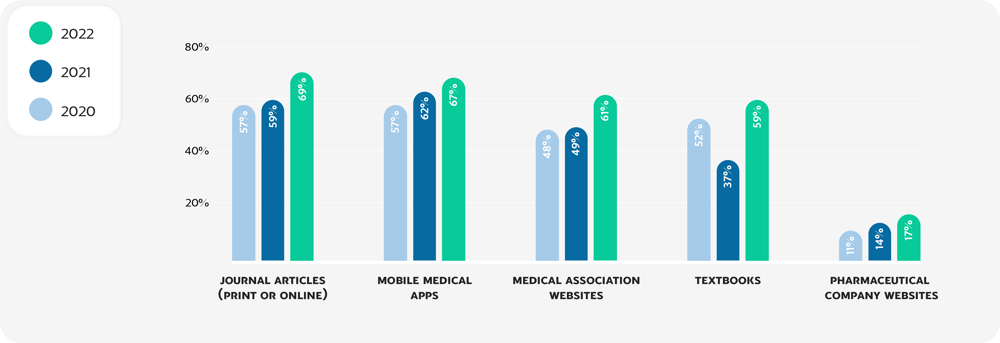What do doctors search for in a medical app?
Medical apps are becoming one of the top three sources of medical information for doctors and their importance is increasing year after year. This should come as no surprise since the digital channels are at the forefrontwith their ability to follow information in real-time and there are not many other professions that need to be in touch with the latest information as much as doctors. Nowadays, medical apps can offer a variety of useful features and content that doctors soon find indispensable. On the other hand, medical apps contain plenty of information about doctors' behaviour and interests and can consequently tell a lot about the state of healthcare.
The most popular sources of information among doctors (source: Digital Doctor 2022):

Numbers don’t lie
We have a unique opportunity to see doctors work through their medical assistant - the Mediately app. Let’s see what kind of information and features are the most interesting and valuable to doctors.
Monday is the day of the week when doctors use our app the most. And what do they search for most often? Looking into drug information is the most frequently used feature, by a little less than 50% of users*. Drug search is followed by clinical tools and the ICD-10 classification, with around 20% each.

Drug searches
In 1950, doctors in practice could expect the total amount of medical knowledge to double every 50 years. By now it takes just 73 days (or even less). In 2022, EMA recommended 89 new medicines and 41 new active substances for authorisation, which means a new medicine almost every four days. New drugs, therapies, and treatments are regularly introduced while existing treatments are refined and updated. This increases the need for doctors to be up to date with all drug information.
It is not surprising that doctors do more than 100,000 searches for different types of drug information every day. Let’s see which group of drugs doctors search for the most. These are:
- Antibiotics
- Gastrointestinal Medications
- Respiratory Medications
- Anti-Inflammatory and Immunosuppressants
- Diuretics
- Pain Medications.
When doctors find a specific drug they are interested in they look into its SmPC, and the drug information chapters they most frequently navigate to are dosing, indications, and packaging. We covered this topic in our previous blog where we looked into SmPC changes and updates - last year there were 114,000 SmPC updates with dosing being one of the chapters that changed the most. Now let’s look at why these chapters are so interesting and relevant for doctors.
Dosing Information:
The dosing chapter provides guidance on how healthcare professionals should administer the medication to patients. It includes detailed instructions regarding the recommended dosage, frequency, and duration of treatment. It also covers dosage adjustments for specific patient populations, such as pediatric or elderly patients, and any special considerations, such as dose titration. Dosing information is crucial for ensuring the safe and effective use of the medication.
Indication Information:
This is a crucial section that outlines the approved medical conditions and situations for which the medication is intended to be used. This chapter offers an overview of the specific diseases, disorders, or symptoms that the drug is designed to treat. It provides doctors with information about the drug's therapeutic purposes, helping them make decisions about its prescription and administration, thereby ensuring that it is used safely and effectively to benefit patients' health.
Packaging Information:
The packaging section includes details on the type of packaging - number of pills, materials used, such as blister packs, vials, or bottles, and any additional components, such as dosing devices or dispensers. This section may also specify storage conditions, such as temperature requirements and protection from light or moisture, to ensure the medication's stability and shelf life.
ICD-10
International Classification of Diseases, 10th Revision (ICD-10) is a diagnostic and procedure coding system endorsed by the World Health Organization (WHO). Each code in the ICD-10 system represents a specific diagnosis or medical condition. The codes are the foundation for documenting the patient’s state of health. Benefits of the unified ICD-10 code are:
- Improved data for epidemiological research (severity of illness, comorbidities)
- Measuring outcomes and care provided to patients
- Tracking public health conditions (complications, anatomical location)
- Making clinical decisions
- Identifying fraud and abuse
- Designing payment systems/processing claims
The most searched ICD-10 codes can provide a glimpse into the prevalent health concerns and conditions that doctors and healthcare professionals encounter in their daily practice.
Which are the most common search codes among doctors using the Mediately app?
- I10 for hypertension stands out as a widely searched code, reflecting the global burden of high blood pressure and the importance of its diagnosis and management.
- I48 represents atrial fibrillation, a common heart rhythm disorder that necessitates careful monitoring and treatment.
- N39.0 corresponds to urinary tract infection, a frequent issue that impacts patients of all ages.
- J18.9 denotes pneumonia, an infection of the lungs that demands prompt intervention.
- I87.2 refers to venous insufficiency and varicose veins, a very common circulatory disorder.
Clinical tools
There has been an increase in the number of physicians who see a definite advantage in digital tools. This shift was enhanced by the COVID-19 pandemic when the benefits of digitalisation and digital tools were more broadly adopted.
Clinical tools are of great help to doctors in their diagnostic and treatment processes. Here, we will see the difference among three specialisations - which clinical tools are the most frequent helpers to general practitioners (GPs), cardiologists, and neurologists.
General Practitioners (GPs):
- BMI (Body Mass Index): General Practitioners frequently use the BMI as a fundamental tool for assessing a patient's weight relative to their height. It provides a quick and reliable measure to identify potential weight-related health issues, such as obesity or underweight conditions.
- CKD-EPI GFR Equation (Chronic Kidney Disease Epidemiology Collaboration Glomerular Filtration Rate Equation): GFR estimation is essential for assessing kidney function. GPs use the CKD-EPI GFR Equation to calculate a patient's estimated glomerular filtration rate, aiding in the early detection of kidney disease. Monitoring kidney function is particularly crucial for patients with chronic conditions like diabetes and hypertension.
- Calculated LDL and non-HDL Cholesterol (Low-Density Lipoprotein and non-High Density Lipoprotein Cholesterol): Managing cardiovascular health is a frequent topic in GP's practice. Calculating LDL-C and non-HDL-C is invaluable for assessing a patient's risk of heart disease. This way, GPs can make better decisions regarding cholesterol-lowering medications and lifestyle modifications.
Neurologists:
- NIHSS (National Institutes of Health Stroke Scale): Neurologists rely on the NIHSS to evaluate the severity of a stroke in patients. This assessment tool helps neurologists to quickly estimate the extent of neurological deficits, guiding decisions on treatment and rehabilitation strategies.
- GCS (Glasgow Coma Scale): The Glasgow Coma Scale is a tool for assessing a patient's level of consciousness. Neurologists and other specialists use it to evaluate patients with neurologic conditions, head injuries, or those recovering from brain surgery. It provides a standardized way to communicate a patient's state of consciousness.
- EDSS (Expanded Disability Status Scale): In the field of neurology, particularly in multiple sclerosis management, the EDSS is used the most frequently. It measures the degree of disability and impairment in patients with neurological conditions, aiding neurologists in treatment planning and assessing the progression of the disease over time.
Cardiologists:
- BMI (Body Mass Index): Similar to GPs, Cardiologists utilize BMI to assess a patient's weight and identify obesity-related risks.
- CKD-EPI GFR Equation (Chronic Kidney Disease Epidemiology Collaboration Glomerular Filtration Rate Equation): Just like GPs, Cardiologists use the MDRD GFR Equation to assess kidney function, as compromised renal function can contribute to heart-related issues.
- CHA2DS2-VASc score: A clinical tool used in the field of cardiology to assess the risk of stroke in patients with atrial fibrillation (AF), a common heart rhythm disorder. It helps healthcare professionals, particularly cardiologists, to evaluate the need for anticoagulation therapy (blood-thinning medication) to prevent stroke in patients with AF.
Conclusion
Medical apps have become a part of doctors' everyday work, with drug information at doctors' fingertips being their greatest asset. They are one of the few channels that can follow the fast-paced healthcare developments and novelties. But with more and more information and content that medical apps will contain, the way they will present and organise it will start to distinguish them in popularity among doctors. For all of us who are working with doctors with an aim to help them treat their patients better and faster, it’s most important to listen to them and follow the changes in their work in order to give them the best possible support.
Sources:
- European Medicines Agency. Medicine evaluation figures.
- American Medical Association. AMA Digital Health Research.
- NEJM Knowledge. Staying Current in Medicine: Advice for New Doctors.
- Johns Hopkins Medicine. Understanding ICD-10.
- Centers for Disease Control and Prevention.

